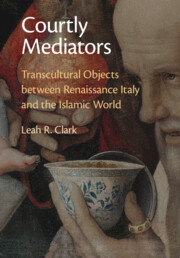Book contents
- Courtly Mediators
- Courtly Mediators
- Copyright page
- Contents
- Plates
- Illustrations
- Preface and Acknowledgements
- Primary Sources and Abbreviations
- Introduction
- Chapter One Diplomatic Entanglements
- Chapter Two Mobile Things/Mobile Motifs
- Chapter Three The Peregrinations of Porcelain
- Chapter Four Fit for the Gods
- Chapter Five From the Silk Roads to the Court Apothecary
- Conclusion
- Appendices
- Bibliography
- Index
Introduction
Courtly Mediators
Published online by Cambridge University Press: 26 July 2023
- Courtly Mediators
- Courtly Mediators
- Copyright page
- Contents
- Plates
- Illustrations
- Preface and Acknowledgements
- Primary Sources and Abbreviations
- Introduction
- Chapter One Diplomatic Entanglements
- Chapter Two Mobile Things/Mobile Motifs
- Chapter Three The Peregrinations of Porcelain
- Chapter Four Fit for the Gods
- Chapter Five From the Silk Roads to the Court Apothecary
- Conclusion
- Appendices
- Bibliography
- Index
Summary
Antonello da Messina’s Saint Jerome in His Study, from around 1475, presents the viewer with a curious architectural setting in which a wooden studio or desk showcases a global range of objects (Plate I). The framing device of the exterior architecture acts as an Albertian window, from which the viewer is invited to enter the scene.1 Two birds (a quail and a peacock) along with a metal barber’s basin, occupy a liminal space, between the exterior world of us, the viewer, and the fictive interior world of the painting.2 Our eye crosses the threshold onto Valencian (or possibly Neapolitan) blue and white tiles to another liminal space: a ledge accessed by three steps, where Jerome has taken off his shoes before climbing the stairs. Placed here on this second liminal ledge are two blue and white pots with plants and a cat, accompanied by a towel and pen case hung on the ‘wall’ above. We now move into Jerome’s space – that of the studio – where he sits on a cathedra chair and reads a book. On the shelf directly above Jerome’s head appears a short albarello, a receptacle used to store spices and medicines from the ‘East’, while beside it another ceramic vessel in blue and white glistens with lustre. The blue and white motifs found on these ceramics and floor tiles – probably a mix of Middle Eastern wares, Spanish imports, local Italian manufacture and maybe even Chinese porcelain – were the result of a global circulation of ceramics. Metalware, some likely decorated with damascene motifs, litter the shelves nestled beside beautifully bound books, indicating the scholarly activities that occurred there, the pages opening up a new world of learning and adventure for the armchair traveller, and by extension, the viewer of the painting.
- Type
- Chapter
- Information
- Courtly MediatorsTranscultural Objects between Renaissance Italy and the Islamic World, pp. 1 - 28Publisher: Cambridge University PressPrint publication year: 2023

